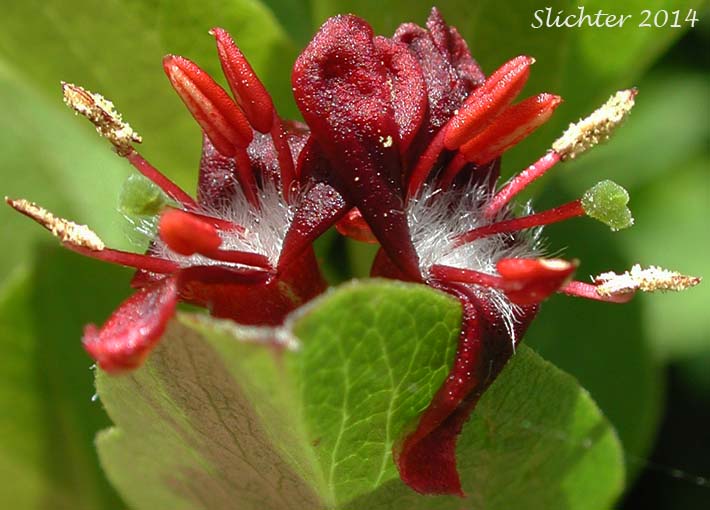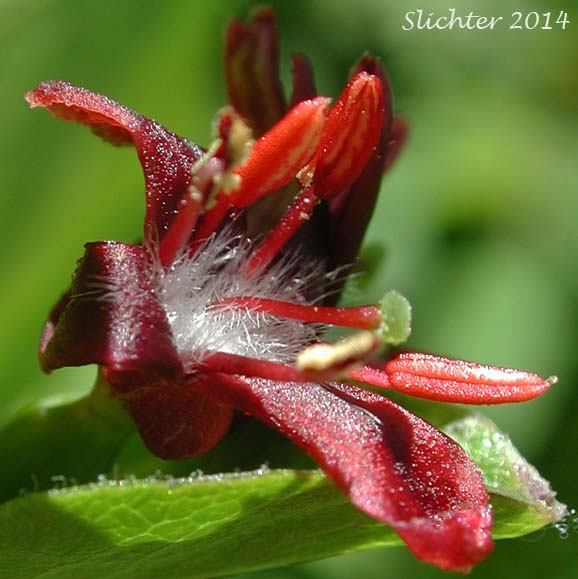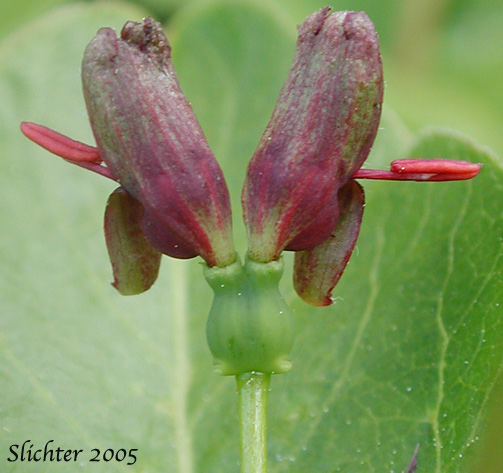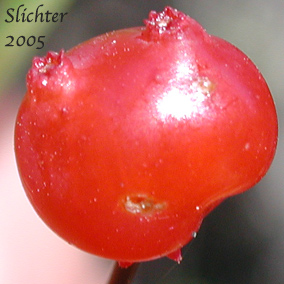Double Honeysuckle, Purpleflower Honeysuckle, Purple-flower Honeysuckle, Purple-flowered Honeysuckle
Lonicera conjugialis

Close-ups of the twin flowers of
twin honeysuckle as seen along the Grassy Knoll Trail about one-half mile east of Grassy Knoll, Gifford Pinchot National Forest.........June 3, 2014. Note the greenish, twin ovaries which
are inferior to the maroon corollas. Note also the numerous whitish hairs in
the mouth of the corolla and the narrow anthers which are held perpendicular
to the filament.
Characteristics:
Twin honeysuckle is an attractive shrub with erect to spreading,
branched stems from 60-150 cm high. The short-petiolate leaves are elliptic,
rhombic or broadly ovate in shape with rounded to acute tips. They range from
2.5-7.5 cm long and 1.5-4.5 cm wide. Both leaf surfaces are more or less covered
with spreading hairs.
The flowers are paired on peduncles 1-4.5 cm long. The corolla
is cup-shaped and two-lipped, the larger upper lip tipped with 4 shallow lobes
while the lower lip is narrower with entire margins. The corolla ranges from
a medium brownish-purple to dark reddishy-purple with greenish streaks. The
throat and internal surface of the corolla is covered with numerous long,
spreading hairs as are the lower sections of the filaments and styles. The
bright red fruits are of the two flowers are united in the middle (See photo
below.) and measure up to 1 cm long.
Habitat:
Twin honeysuckle may be found in meadows and
moist open slopes as well as open woods from the lowlands to well into the
mountains.
Range:
Twin honeysuckle may be found in the Cascade
Mts. from Mt. Adams south to the Sierra Nevada of California.
In the Columbia River Gorge, it may be found
between the elevations of 100'-3900' from near Crown Point east to near Hood
River, OR.
 -
- 
Close-ups of the twin flowers of
twin honeysuckle as seen along the Grassy Knoll Trail about one-half mile east of Grassy Knoll, Gifford Pinchot National Forest.........June 3, 2014.

The photo above shows a close-up of the back
surfaces of the twin flowers of purple-flowered honeysuckle as seen at about
4000' along a road along the northern side of the ridge that separates the Dairy
and Cougar Creek drainages at the southeastern corner of Mt. Adams........June
11, 2005. To me, the flowers from this angle look like frogs leaping to catch
their prey with their sticky tongues (the stamens in this case)! Note the inferior,
greenish ovaries which are joined much of their length. See the mature fruit
that develops from the ovaries below.

The photo above shows a close-up of the leaf of purple-flowered
honeysuckle as seen at about 4000' along a road along the northern side of the
ridge that separates the Dairy and Cougar Creek drainages at the southeastern
corner of Mt. Adams.........June 11, 2005.

The two photos above show different views of
the fruit of twin honeysuckle. Note the long pedicel in the upper photo. The
lower photo shows a close-up of the fruit, which is a berry. The berry is unusual
in that it represents 2 ovaries (from each of the "twin" flowers)
that are joined much of their length. The 2 protuberences on the berry represent
where the 2 corollas each attached. Photographed at Island Springs Creek on
the Island Springs Trail #66 on the eastern slopes of Mt. Adams.........August
25, 2005.
Paul Slichter

